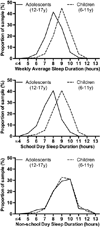Sleep in the modern family: protective family routines for child and adolescent sleep
- PMID: 26779564
- PMCID: PMC4712736
- DOI: 10.1016/j.sleh.2014.12.002
Sleep in the modern family: protective family routines for child and adolescent sleep
Abstract
Study objectives: The overall objective of the 2014 National Sleep Foundation Sleep in America Poll "Sleep in the Modern Family" was to obtain a current picture of sleep in families with at least 1 school-aged child.
Design: Cross-sectional poll.
Setting: Internet-based interview.
Participants: Nationally representative Internet panel of US households with a child 6-17 years.
Measurements and results: Primary measures included parental perception of the importance of sleep, parental and child sleep quality, child sleep duration and habits, technology in bedroom, and family rules. Parents/guardians (n= 1103; mean age, 42; 54% female) completed the survey. Although the majority of parents endorsed the importance of sleep, 90% of children obtain less sleep than recommended. Significant predictors of age-adjusted sufficient sleep duration (estimated conservatively as ≥9 hours for ages 6-11 years and ≥8 hours for ages 12-17 years) included parent education, regular enforcement of rules about caffeine, and whether children left technology on in their bedroom overnight. Significant predictors of excellent sleep quality included whether a bedtime was always enforced and whether children left technology on overnight.
Conclusions: Children generally have better age-appropriate sleep in the presence of household rules and regular sleep-wake routines. Sufficient sleep quantity and adequate sleep quality were protected by well-established rules of sleep hygiene (limited caffeine and regular bedtime). In contrast, sleep deficiency was more likely to be present when parents and children had electronic devices on in the bedroom after bedtime. Public health intervention goals for sleep health might focus on reducing the encroachment of technology and media into time for sleep and supporting well-known sleep hygiene principles.
Figures


Similar articles
-
Developmental aspects of sleep hygiene: findings from the 2004 National Sleep Foundation Sleep in America Poll.Sleep Med. 2009 Aug;10(7):771-9. doi: 10.1016/j.sleep.2008.07.016. Epub 2009 Mar 12. Sleep Med. 2009. PMID: 19285450
-
Parental Expectations Are Associated with Children's Sleep Duration and Sleep Hygiene Habits.J Dev Behav Pediatr. 2020 Sep;41(7):550-558. doi: 10.1097/DBP.0000000000000818. J Dev Behav Pediatr. 2020. PMID: 32433218
-
Sleep habits and pattern in 1-14 years old children and relationship with video devices use and evening and night child activities.Ital J Pediatr. 2017 Jan 13;43(1):7. doi: 10.1186/s13052-016-0324-x. Ital J Pediatr. 2017. PMID: 28257638 Free PMC article.
-
Healthy Habits, Happy Homes: randomized trial to improve household routines for obesity prevention among preschool-aged children.JAMA Pediatr. 2013 Nov;167(11):1072-9. doi: 10.1001/jamapediatrics.2013.2356. JAMA Pediatr. 2013. PMID: 24019074 Clinical Trial.
-
Treatment of behavioral sleep problems in children and adolescents - literature review.Psychiatr Pol. 2016;50(3):571-84. doi: 10.12740/PP/41294. Psychiatr Pol. 2016. PMID: 27556115 Review. English, Polish.
Cited by
-
Beyond sleep duration: Sleep timing as a risk factor for childhood obesity.Pediatr Obes. 2021 Jan;16(1):e12698. doi: 10.1111/ijpo.12698. Epub 2020 Jul 29. Pediatr Obes. 2021. PMID: 32729172 Free PMC article.
-
The development of a scale to assess children's and adolescents' sleep environments.J Clin Sleep Med. 2022 Oct 1;18(10):2353-2365. doi: 10.5664/jcsm.10110. J Clin Sleep Med. 2022. PMID: 35702021 Free PMC article.
-
Household chaos and sleep-disturbing behavior of family members: results of a pilot study of African American early adolescents.Sleep Health. 2017 Apr;3(2):84-89. doi: 10.1016/j.sleh.2016.12.006. Epub 2017 Jan 22. Sleep Health. 2017. PMID: 28346162 Free PMC article.
-
Examining Sleep and Mood in Parents of Children with Sleep Disturbances.Nat Sci Sleep. 2020 Oct 30;12:865-874. doi: 10.2147/NSS.S271140. eCollection 2020. Nat Sci Sleep. 2020. PMID: 33154690 Free PMC article.
-
24-Hour movement behaviours and COVID-19 among children in the Kingdom of Saudi Arabia: A repeat cross-sectional study.Sports Med Health Sci. 2022 May 21;4(3):177-182. doi: 10.1016/j.smhs.2022.05.001. eCollection 2022 Sep. Sports Med Health Sci. 2022. PMID: 36090920 Free PMC article.
References
-
- Wolfson AR, Montgomery-Downs HE. The Oxford handbook of infant, child, and adolescent sleep and behavior. USA: OUP; 2013.
-
- Mindell JA, Meltzer LJ, Carskadon MA, Chervin RD. Developmental aspects of sleep hygiene: findings from the 2004 National Sleep Foundation Sleep in America Poll. Sleep Med. 2009;10(7):771–779. - PubMed
Grants and funding
LinkOut - more resources
Full Text Sources
Medical

